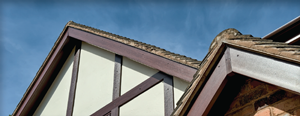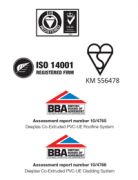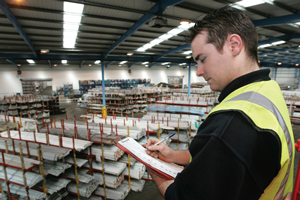
Technical Data Sheets
- fitting-guide1
Technical Data Sheets
Quality and certification

Appearance
Physical characteristics
Coefficient of linear expansion 5 x 10-5/°K (Foam)
Performance in Fire
BS 476: Part 6: 1981 (Text Report 204982 – RTF/662) Fire propagation: I = 18.0,il = 8.8,i2 = 7.8, i3 = 1.4.
BS 476: Part 7: 1987: Surface spread of flame - Class IY
Deeplas cladding cellular foam profiles conform to the following standards:
BS 476: Part 6: 1981: (Text Report 204923 – RTF/663) Fire propagation: I = 11.7, il = 3.7, i2 = 5.5, i3 = 2.5.
BS 476: Part 7: 1987: Surface spread of flame - Class I
Biological & chemical resistance
Environmental facts
KM 556478
Assessment report number 10/4765
Deeplas Co-Extruded PVC-UE Roofline System
Assessment report number 10/4766
Deeplas Co-Extruded PVC-UE Cladding System

Deeplas system components are manufactured and supplied to strict quality standards backed by ISO 9001 certification.
Deeplas profiles are manufactured in accordance with BS 7619.
In addition Deeplas co-extruded PVC-U roofline and cladding has been independently tested and awarded BBA certification.
Storage and precautions

Storage
• Store in a shaded area.
• In the sun, you obtain a greenhouse effect in the plastic packaging causing profile distortion and mould growth.
• Do not expose protective foil to the sun for prolonged periods (It will be hard to remove and the printing may be transferred to the profile surface).
Handling precautions
- Wear a CE approved coarse particle dust mask
- Wear eye protection
When unloading
- Unload by hand
Thermal movement
Allow a minimum 5mm clearance at the end of each 5 metre length of profile, in order to accommodate expansion. (Foiled 8mm expansion)
Temperatures of Use
Profiles should not be fixed when the temperature is Below 0°C or above 30°C. Before using profiles, acclimatise them to the temperature of the workplace (i.e. do not use warm profile straight away on a cold site).
Tools
General:
The system components are easy to work using normal woodworking tools for cutting, drilling and shaping.
Handsaws:
Fine toothed blade.
Power tools:
Carbide tipped blade.
Running speeds:
Similar to or preferably higher than those used for timber.
Sealants
Use a low-modulus silicone sealant conforming to BS5889. Refer to chosen manufacturers recommendation.
Note - Primers may be necessary when bonding to certain materials
Maintenance

Cleaning
Profiles can be washed with water and mild, non-abrasive detergent. Solvent based cleaners or cleaning agents containing chlorine should not be used. Contact with composites based on bitumen should also be avoided.
Solutions developed specifically to clean the profile are also available from Deeplas. For cleaning white profile you can use Decoclean, and for foiled you can use Cleanup.
Repairs
Scratches are difficult to repair entirely but they can be polished out using wet and dry papers. Start with an appropriate grade (180 or 360) moving down to 1000 grade.
Finally, polish with a cream cleaner.
Painting
Painting of the product is not recommended. It can cause embrittlement and dark colours will cause thermal distortion.